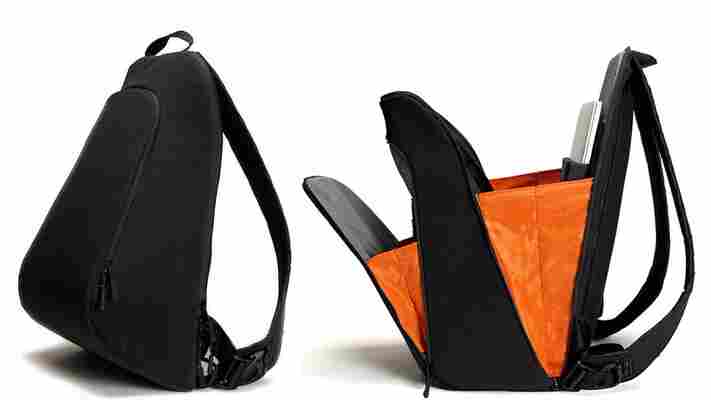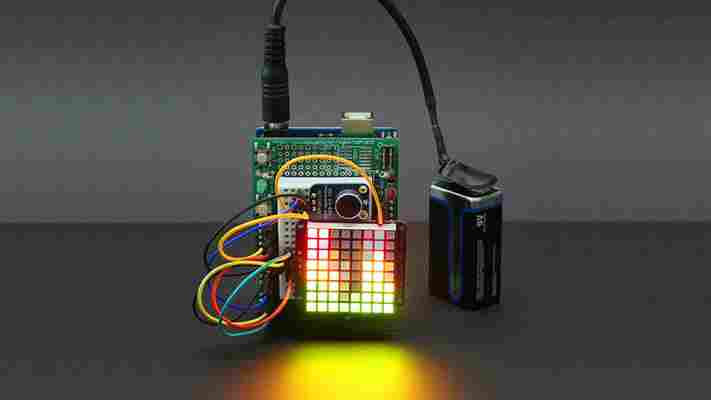When I first reported on Slim Pack, I said it may be the perfect backpack. SlimFold , the company behind Slim Pack, asked me to test my theory — and I wasn’t disappointed.

Slim Pack is made up (almost entirely) of a lightweight, water resistant material. It’s exceedingly thin, but really durable. I happen to have an expensive Nike rain suit made of the same fabric, and have been outside during some torrential Oregon downpours; I’ve got no concern this one isn’t going to hold up to rain.
The zippers are also sealed, rounding out the Slim Pack’s water resistance nicely. On one side, there’s a stretchy pocket for a water bottle — but that’s really about there is to the outer shell.
Slim Pack’s straps employ a unique joint that allows them to pivot just under your armpit, making them comfortable for just about anyone. Those straps can also be had with a chest strap if you’re into that (my test model didn’t have it).
There’s also a small handle up top, and the rear is slightly padded to allow for airflow between your back and the pack. Slim Pack has some padding on the outside layer as well, mostly to keep its shape.
If you’ve seen the GIFs on Slim Pack’s Kickstarter page and thought ‘yeah, right,’ think again.
Slim Pack is actually water resistant to a degree that borders on IP rating. It’s not completely sealed, so I can’t say it’s waterproof , but you won’t have to worry about your belongings if you’re out in the elements. Its Kickstarter campaign refers to Slim Pack as ‘weatherproof,’ which is accurate.
The zippers may be sealed, they’re not waterproof; all that means is that you shouldn’t try to submerge Slim Pack. For normal use, there’s absolutely nothing to worry about.
It doesn’t even stay wet. The material it’s made of beads water away; a quick shake when you get to your destination flips most water off.
One thing to keep in mind is that the rear of the pack as well as the straps aren’t made of the same material, so they will retain water if wet. The side pocket is also a different material, but has to be as the water resistant material the shell is made of isn’t stretchy.
If you’re a fan of simple, effective, minimal design — Slim Pack will excite you.
The outer shell is four simple pieces of that ‘weatherproof’ material and a water bottle pocket, with the front merging into the bottom. Two zippers are the only interruption when facing the bag.
Inside, the pack is equally simple. The main compartment has nothing but a removable computer divider, and the secondary pouch has some simple pockets.
The main divider in that second pocket was designed for an iPad, while the rest are fairly straightforward and open to your needs. I slipped a SSD drive, iPhone 6S Plus and wallet into the bag with ease (and plenty of room left for other stuff).
Slim Pack also opens accordian-style. A few pieces of fabric on the inside of each zippered compartment keep Slim Pack from losing its shape while open, and prevent your stuff from spilling out.
Slim Pack is a work of art. It also has a few tradeoffs.
The minimalist interior begs for more. In a Kickstarter video, its creator Dave Zuverink uses zippered pouches to hold cables and chargers in the main compartment. I did the same, but used an Eagle Creek travel cube.
While the bag doesn’t have a dedicated home for your cables and such, I found the packing cube to be a welcome addition to the bag; I actually prefer it to the more traditional ‘everything in its place’ bags.
Having a water resistant bag is great for an Oregonian like me, but let’s be realistic: it’s not as if any of us will be in rain for a bulk of our time. Still, the material Slim Pack is made of is wonderful beyond being resistant to rain.
It picks up scuffs a bit easier than a traditional backpack, but they’re easily removed with a wet hand or cloth. Unfortunately, You’ll want to watch where you set the bag down; the bottom has no added protection.
I’ll note that my rain suit made of the same material as Slim Pack is machine washable, but Slimfold makes no claims that its bag is. Logically, I can’t see why you wouldn’t be able to machine wash and line dry the bag, though.
Slim Pack’s zippers are also tight. Between the overlying flap and diminutive size, they’re not easy to use with one hand. If you’re a ‘rip the bag open to grab my stuff’ type of person, Slim Pack takes a bit of getting used to.
It’s also not able to pack flat, so keep that in mind if you’re considering it for travel. The bag has a touch of high-density EVA padding, and the curved front bottom doesn’t lend itself to flat packing. You could, but you risk compromising the bag’s integrity. It’ll fit under the seat in front of you on a plane just fine, though.
Update : It seems Slim Pack’s padding is actually removable via the bottom of the interior. I won’t speak to how easy it would be to work the padding back into the front of the pack, but turning it inside-out actually allows access to the padding. Machine washable and flat-packable, but likely tricky to re-stuff once it’s removed.
I was struck with how comfortable Slim Pack is, too. I’m 6’2”, and like a pack to sit higher up on my back. Slim Pack is perfect for that, and the adjustable straps fit better than any bag I’ve ever used.
It’s also remarkably light. I tend to travel with a MacBook, and often face-palm myself for having backpacks heavier than the sum of what I put into them. Slim Pack is probably lighter than what’s inside, as a backpack should be.
My test bag also came with a yet-to-be-announced keyring holder, which has a dongle for your keys that attaches to a receiver in the bag. If I were a city-dwelling commuter, I’d use that feature daily.
Slim Pack is positioned for commuters, especially those on bikes. For them, the bag is a no-brainer. Slim Pack is svelte, modern, lightweight and water resistant; there’s not much more you can ask for.
Many of us who don’t fit that category will also find Slim Pack great. I like to pack light when I travel, making Slim Pack just about perfect. There’s nothing too complicated about it, and while its simplicity begs for add-ons like a packing cube, it’s nicer than having to figure out what stuff goes in which pocket like I have to with other bags.
The only buyer Slim Pack may not be for is one who packs heavy, or has a massive computer. Slim Pack can accommodate a 15-inch MacBook Pro just fine, but if you’ve got a larger computer, I can’t say Slim Pack would work for you even with the divider removed. It’s possibly less durable than some other backpacks, but I’m not a one to abuse bags, so that’s not concerning. If you find yourself tossing bags onto a seat on the train or drop-kicking them under your desk, Slim Pack may not be your best choice.
In testing Slim Pack, I compared it to a few other bags I have. I also donated those bags to Goodwill once I started using Slim Pack.
There might not be a higher compliment I can pay it.
Trade-offs exist with Slim Pack, but that can be said for any bag. Now that I’ve used the packing cube with Slim Pack, it’s a much better experience than buying a heavy structured bag with a ton of pockets.
For most, this will be a fantastic bag. I really like the minimalist approach to design and functionality; Slim Pack does exactly what I need it to, how I want it to.
It may be a bit pricey at $179, but any concerns you have about cost assuage once you use it. Given my proclivity to travel as simply as possible and stay productive , Slim Pack is a hands-down winner for me.
Note: If you’re interested in grabbing a Slim Pack, check out the Kickstarter campaign . It still has 26 days to go, and a few funding options that might save you a few bucks. I’ll also note Slim Pack is already being sampled (which is why I am able to test it), and Zuverink tells me everything is on pace for a December delivery schedule as promised — and he’s never given me reason to doubt him.
This DIY Arduino-based visualizer grooves to music playing around you
Love music? Like tinkering with hardware? This nifty Arduino project combines both interests by taking you through the process of building a visualizer that reacts to any song playing in your surroundings.

It’s a cool little gizmo to have on your desk to show off your mad DIY skills. Simply set it next to a speaker and watch the lights begin to dance in time to the beat.
You’ll need an Arduino board, the project code base from GitHub , a microphone amplifier, an LED pixel matrix, and a couple of other parts to put this together.
If you want to take things a step further and create a pocket-sized version, you can follow Adafruit’s advanced instructions to build one that’s only a little larger than a 9V battery.
➤ Tiny Arduino Music Visualizer [Adafruit via Lifehacker ]
Nest’s smart thermostat goes on sale in Europe with hot water control for €249
Nest has announced that its third-generation Learning Thermostat is now available in the UK, France, Netherlands, Belgium and Republic of Ireland.

The £199 device, which launched in the US in September , features a larger and sharper screen than the previous version and brings two handy features exclusive to Europe.
The first is the ability to control your hot water tank and adjust its schedule from the device or your phone. There’s also an Auto-Away function that helps save energy when you’re not home for more than a couple of days.
The second feature, called OpenTherm, works with compatible boilers to figure out how much gas to burn in order to maintain your preferred temperature. Nest says that this works better than turning your boiler on and off as it helps save energy and extends the life of your heating system.
The device is available at £199 (€249) from Nest’s online store as well over 2,500 locations across Europe.
➤ Meet the 3rd gen Nest Learning Thermostat [Nest Blog]
